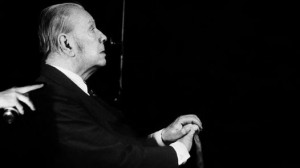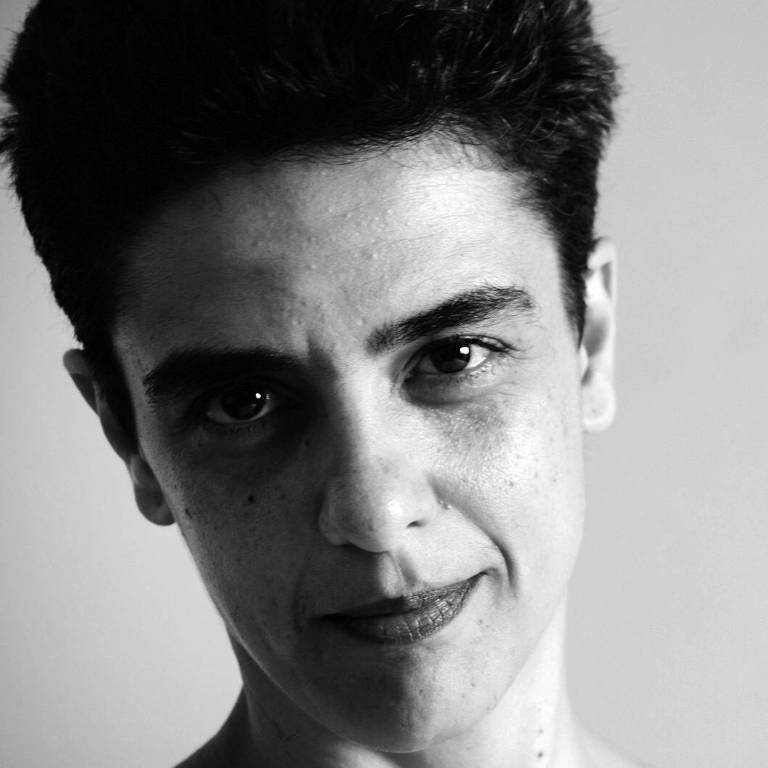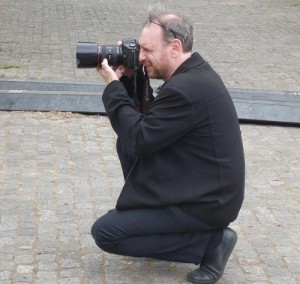O fotógrafo dos escritores perde seu acervo
Certa vez, quando foi fotografar o escritor argentino Adolfo Bioy Casares, ao lado da cama do autor, em sua casa, este lhe disse: “A eternidade é uma das raras virtudes da literatura”. A frase ficou na cabeça de Daniel Mordzinski, 53, fotógrafo argentino radicado na França que há trinta anos se dedica a retratar escritores em situações fora do convencional. Em suas imagens, vemos o israelense Amos Oz parado no meio do deserto, o argentino Andrés Neuman deitado numa mesa de bilhar, seu compatriota Ricardo Piglia posando entre cabides, Zélia Gattai com uma coleção de imagens religiosas, o mexicano Juan Villoro cabeceando uma bola de futebol, Federico Andahazi saindo de um táxi e inúmeras cenas inusitadas.
 Mordzinski começou a fazer suas chamadas “fotinskis” em 1978. Tinha apenas 18 anos, sonhava ser escritor e estava buscando oportunidades. Até que Ricardo Wullicher, produtor e amigo, o chamou para acompanhar a filmagem de “Borges para Millones”. Mordzinski, então, teve a oportunidade de fazer a foto acima, na qual temos o célebre gênio argentino mirando o horizonte. A partir daí, Mordzinski começou a se dedicar a fotografar escritores, tendo como objetivo, um dia, reunir um grande atlas da literatura latino-americana e espanhola.
Mordzinski começou a fazer suas chamadas “fotinskis” em 1978. Tinha apenas 18 anos, sonhava ser escritor e estava buscando oportunidades. Até que Ricardo Wullicher, produtor e amigo, o chamou para acompanhar a filmagem de “Borges para Millones”. Mordzinski, então, teve a oportunidade de fazer a foto acima, na qual temos o célebre gênio argentino mirando o horizonte. A partir daí, Mordzinski começou a se dedicar a fotografar escritores, tendo como objetivo, um dia, reunir um grande atlas da literatura latino-americana e espanhola.
 Lendo e, principalmente, escutando os autores, passou a inspirar-se. Foi assim com o peruano Mario Vargas Llosa. O autor de “Lituma nos Andes” contou em uma palestra que sempre desobedecia sua mãe quando ela lhe pedia que apagasse a luz para dormir. Ele, então, acendia uma vela e seguia lendo. Mordzinski não teve dúvidas, naquele mesmo dia comprou uma vela e apareceu no quarto de Vargas Llosa, no hotel, para reconstruir a cena de sua infância. O resultado é a foto acima.
Lendo e, principalmente, escutando os autores, passou a inspirar-se. Foi assim com o peruano Mario Vargas Llosa. O autor de “Lituma nos Andes” contou em uma palestra que sempre desobedecia sua mãe quando ela lhe pedia que apagasse a luz para dormir. Ele, então, acendia uma vela e seguia lendo. Mordzinski não teve dúvidas, naquele mesmo dia comprou uma vela e apareceu no quarto de Vargas Llosa, no hotel, para reconstruir a cena de sua infância. O resultado é a foto acima.
Há escritores no banheiro, outros em suas camas (Gabriel García Márquez), sem roupa (Wendy Guerra), quase irreconhecíveis no canto de alguns quadros, ou retratos escancarados, meditativos, poses naturais e armadas. Nas últimas três décadas, Mordzinski viajou por vários países, presenciou inúmeros festivais, principalmente os Hay de Cartagena e Xalapa, e tirou inúmeras fotos.
Após ser correspondente de guerra no Oriente Médio nos anos 80, Mordzinski se instalou em Paris, onde é correspondente do jornal espanhol “El País”. Ali, num escritório do jornal “Le Monde”, guardava os negativos de toda uma vida de trabalho. Pois o diário francês acaba de destruir, por acidente, seu acervo de mais de 50 mil negativos. Ao desalojar a sala para destiná-la para outro fim, o trabalho do fotógrafo foi quase todo para o lixo.
Desesperado, Mordzinski escreveu para outros jornais e em seu site, pedindo uma retratação, que veio após algumas semanas. O fato ganhou ampla repercussão em cadernos de cultura de todo o mundo. E Mordzinski foi defendido por toda a comunidade de escritores, muitos jornalistas e articulistas. O que se perdeu para sempre, porém, foram suas fotos. Por sorte muito havia sido publicado, e pode ser visto também em seu site www.danielmordzinski.com, mas o sonho do atlas das letras ibero-americanas ficou mais complicado de cumprir.



888 On this world model, every merchandise has grow to be extravagant. In the meantime, he’s also operating while using the sweatshop, damier speedy 30 run by Chinese bosses, louis vuitton artsy gm that manufacture the counterfeit items for his sales and profits drive.
cheap burberry quilted jacket for sale http://greeninmedusa.com/cheap-burberry-quilted-jacket-c-3.html
I think the admin of this O fotógrafo dos escritores perde seu acervo | Sylvia Colombo – Folha de S.Paulo – Blogs is really working hard for his site, for the reason that here every stuff is quality based stuff.
spaccio woolrich bologna http://www.woolrich.arkis.it/
czmlby
Moncler bottes http://www.circuitindedusud.fr/26-moncler-bottes89565623
I just couldn’t depart your web site prior to suggesting that I extremely enjoyed the standard info a person provide for your visitors? Is going to be back often in order to check up on new posts
I happen to be writing to let you be aware of what a fabulous experience my wife’s girl experienced checking your site. She noticed lots of details, including what it is like to possess a wonderful giving nature to get the rest without difficulty know some specialized subject areas. You undoubtedly exceeded my expected results. I appreciate you for presenting such interesting, trusted, educational and as well as easy tips on the topic to Janet.
Great blog article. Great.
snapback cheap
Hello, i think that i saw you visited my blog thus i came to “return the favor”.I am trying to find things to improve my site!I suppose its ok to use some of your ideas!!
??? ??|??? ??|???|||www.mmtc.or.jp/cgi-bin/blog/archives/prada-c1.html|||??? ??|??? ??|???
???? ?? http://yqhosp.tsinghua.edu.cn/css/com7.chanel-c1.html
Lady Griz hand Selvig 800th career win with 68 61 victory over PortlandGriz up to fifth in TSN poll, highest ranking of seasonBig Sky honors Sac State QB SafronNorth Dakota football coach firedSince 1897, the Cat Griz rivalry has captivated the stateFamily health: Prepare yourself and your vehicle for winter drivingFitness calendarBirths for Tuesday, November 19Angler with 4th place total takes Fall Mack Days fishing tournament titleWestern Montana hunters get help from fresh snow, rutIf the name Grace Coddington is familiar, you’ve probably seen the 2009 documentary film “The September Issue” about Vogue magazine’s Editor in Chief Anna Wintour, the most feared and revered woman in fashion. Now Coddington, the longtime creative director of Vogue, has her own star vehicle, an engaging memoir titled “Grace,” co written with Michael Roberts. For anyone with a passing interest in the fashion industry, it’s worth a read for the name dropping alone.As became clear in the film, which chronicled the magazine’s staff as they put together the 4 pound September 2007 issue, Coddington is not the Anna Wintour or Diana Vreeland type. You won’t hear her barking orders at assistants or making dramatic pronouncements about pink.But she is equally passionate, a wild haired dreamer who thinks that fashion should be transporting, provocative and even intellectual, who bemoans the dominance of celebrities and digital hocus pocus in fashion photography and who isn’t afraid to take on Wintour.The book is a window into how fashion has changed from a small, niche business into a global pop culture medium. It chronicles Coddington’s 50 years in the industry, first as a model, then as a fashion editor for British Vogue and finally as creative director for American Vogue, with lots of juicy anecdotes about designers, photographers, celebrities and models.She compares the fashion world then and now and offers clues into her relationship with Wintour. She’s also open about her private life, including details about failed marriages, the tragic death of her sister Rosemary and her 30 year romance with French hairstylist Didier Malige. She tells colorful stories behind many of the fashion shoots she has styled, but I do wish she had offered more insight into her role in the creative process.Coddington begins by painting a picture of her upbringing as romantic as any photo shoot. For her first 18 years, her home was the Trearddur Bay Hotel on the island of Anglesey off the coast of North Wales. “Although it was bleak, I saw beauty in the bleakness.” When she wasn’t outdoors, she amused herself by looking at picture books, reading fairy tales and, yes, studying the pages of Vogue magazine. As a teen, she went to a convent school and has vivid memories of the nuns roller skating on the rooftop, “flapping about surreally in their robes like crows on wheels.”At 18, she moved to London to attend a modeling course advertised in Vogue. The fashion world was much different in 1959. Coddington had to learn how to apply her own makeup and style her own hair, because makeup artists and hairdressers specializing in photo shoots were nonexistent. A meeting with photographer Norman Parkinson led to her first modeling job running naked through the woods for an arty fashion catalog.Coddington became an overnight success. “I was a character, rather than a pretty model, and I suppose that’s exactly what I look for in the girls I now select to put in American Vogue the ones who are quirky looking.”She earned the nickname “The Cod” (to Jean Shrimpton’s “The Shrimp”), danced the twist on Mary Quant’s catwalk and became a muse to Vidal Sassoon, who created his famous five point cut on Coddington. Her modeling career was derailed for two years by a car accident, which scarred her left eyelid. But eventually things picked up again, and she settled into life in 1960s swinging London and Paris, hanging out with a fast crowd that included Michael Caine, Jane Birkin, the Beatles and the Rolling Stones.Her fashion editing career coincided with the beginning of her relationship with Michael Chow and the opening of his glamorous restaurant Mr. Chow, which attracted a starry crowd. “Naturally, we were forever being photographed at home, draped among our symbols of ‘with it ness’ as one of London’s most happening couples; him, the cool young restaurateur, nonchalantly swinging in a hammock hung from the minstrel’s gallery and me, the sophisticated style maker, perkily sitting cross legged atop a giant pop art version of a Campbell’s soup can.”At the height of the bohemian 1970s, she dyed her hair with henna and permed it (it would stay the same for much of the next 40 years), dressed almost exclusively in Yves Saint Laurent, had a fling with a Vietnamese photographer and spent her evenings at Club Sept in Paris. Coddington worked with the who’s who of fashion. She shot Anjelica Huston with photographer David Bailey and Pat Cleveland with Helmut Newton.When Bea Miller, who had edited British Vogue for 22 years, retired, Coddington interviewed for the job but says she knew deep down she wasn’t suited for it and thought that Wintour, then the creative director of American Vogue, should get it.Wintour did get it. Two days into her editorship, she invited Coddington to a screening of the racy film “Betty Blue.” The two sat in dead silence through the opening sequence, a vivid five minute sex scene.”Anna was rigid and unmoving. No sign of any emotion at all,” Coddington writes. “I then realized how much significance Anna places on willpower trumping feelings.”In 1988, when Wintour was appointed editor in chief at American Vogue, Coddington asked to join her. Coddington’s narrative style fashion features and travelogues, a sampling of which appear in the book, became the heart and soul of the magazine, even as its pages became increasingly taken over by celebrities. Through her visual canvases, she interpreted the New Romantic period, grunge and the South Beach blinged out 1990s, and persuaded superstar designers Tom Ford, Marc Jacobs and others to play roles in a shoot based on “Alice in Wonderland.”She sums up her creative process this way: “For me, one of the most important aspects of my work is to give people something to dream about, just as I used to dream all those years ago as a child looking at beautiful photographs.”The book ends with a chapter on then and now. “Fashion has changed so much in my lifetime,” Coddington writes. “Today, I find myself at the collections, asking, ‘Who are all these people?’ Sometimes I think I’m the last remaining person who comes to the shows for the pleasure of seeing the clothes.”At 71, she seldom wears makeup and doesn’t socialize much. But her attempt in the last 100 pages to distance herself from the term “fashionista” is a bit of a stretch. Clearly, Coddington has led a most charmed life. Otherwise, we wouldn’t be reading about it.We provide this community forum for readers to exchange ideas and opinions on the news of the day. Passionate views, pointed criticism and critical thinking are welcome. Comments can only be submitted by registered users. By posting comments on our site, you are agreeing to the following terms:
????? ???????
The University O fotógrafo dos escritores perde seu acervo | Sylvia Colombo – Folha de S.Paulo – Blogs of Cincinnati, founded in ??????? 1 1819 because of the city and from now on controlled from the state, is the city’s largest institution of higher learning. Also the following are Xavier University, founded in 1831. Hebrew Union College, founded in 1875, was the original institution of Jewish higher learning in america.
xibrhnt
moncler ski http://bazzinisedici.it/18-moncler-cappotti-uomo59626562
Due to the fact that the account, Inter went on to bash Bayern Munich 2-0 in the definitive to be crowned Europes champions after 45 years. They followed it up with an Italian Cup and Coalition twofold, in advance Mourinho port side for Legitimate Madrid. There was a Conspiring with and Cup double seeking Bayern as adequately, along with Chelsea, who did remarkably properly in England. Barca had to make do with the Spanish Federation title.
canada goose uk stockist http://pineappleart.net/wordpress/canada-goose-uk-stockist-2014-baby-happy-new-year-happy-birthday/